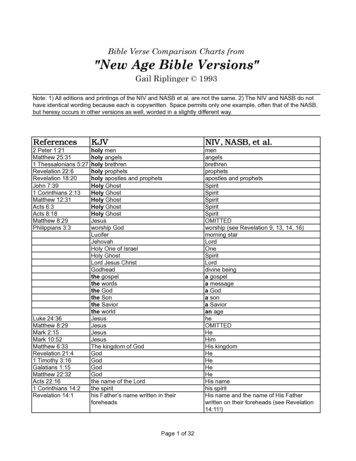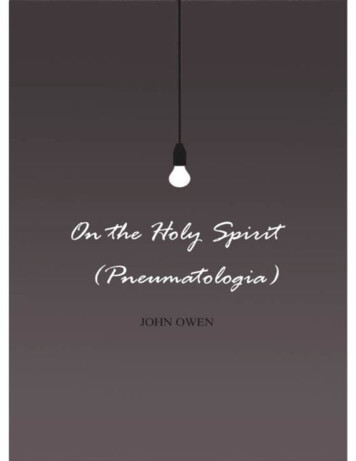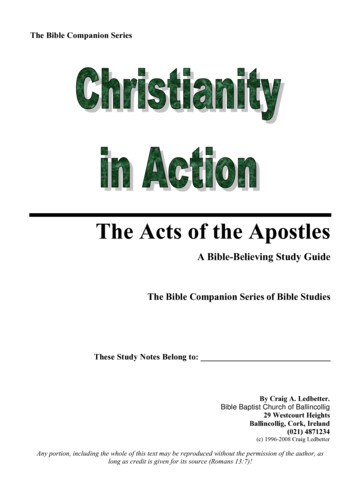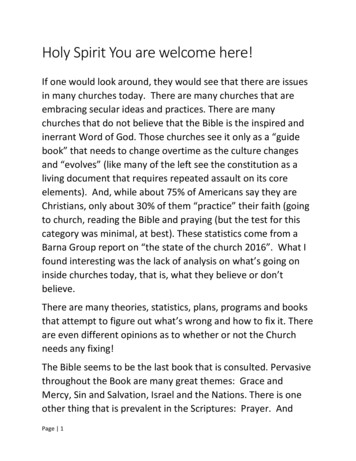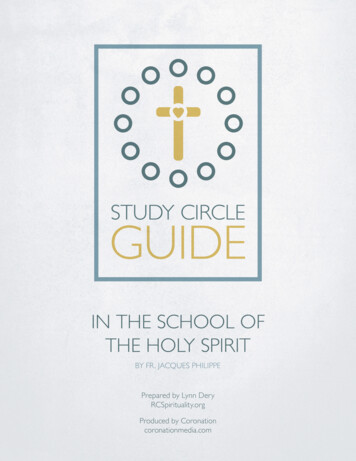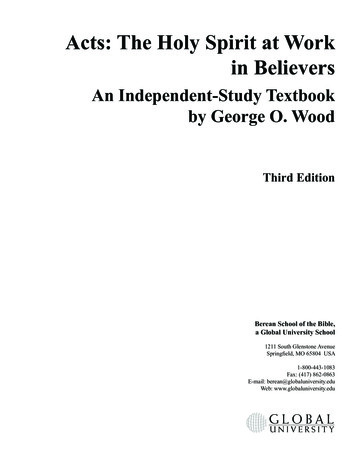
Transcription
Acts: The Holy Spirit at Workin BelieversAn Independent-Study Textbookby George O. WoodThird EditionBerean School of the Bible,a Global University School1211 South Glenstone AvenueSpringfield, MO 65804 USA1-800-443-1083Fax: (417) 862-0863E-mail: berean@globaluniversity.eduWeb: www.globaluniversity.edu
Dr. George O. Wood currently serves as the General Superintendent of the General Council of theAssemblies of God. The son of missionary parents, he pastored Newport-Mesa Christian Center in Costa Mesa,California, from 1971 until 1993. In addition to his pastoral responsibilities there, he conducted two daily radioand television programs and served as part-time professor at Vanguard University and as Adjunct Professorof Preaching at Fuller Theological Seminary. During this time he served as the assistant superintendent ofthe Southern California District of the Assemblies of God from 1988 until 1993. Prior to being elected as thechief executive officer of the Assemblies of God, Dr. Wood served the Fellowship as its general secretary forfourteen years. He has authored five books and numerous articles in Christian periodicals.After receiving his bachelor of arts degree from Evangel University in Springfield, Missouri, he earned ajuris doctorate from Western State University College of Law in Fullerton, California. He also holds the Doctorof Pastoral Theology degree from Fuller Theological Seminary in Pasadena, California. Dr. Wood is an attorneyand a member of the California State Bar.Global UniversitySpringfield, Missouri, USA 2005, 2006, 2010 Global UniversityAll rights reserved. First edition 2005Third edition 2010Unless otherwise indicated, Scripture is taken from the Holy Bible, NEW INTERNATIONAL VERSION . Copyright 1973, 1978, 1984 International Bible Society. All rights reserved throughout the world. Used by permission ofInternational Bible Society.PN 03.15.02ISBN: 978-0-7617-1456-9Printed in the United States of America by Gospel Publishing House, Springfield Missouri
Table of ContentsEnrollment Information for Berean Courses.5How to Use Berean Courses.6Course Introduction: Studying the Birth of the Church.10UNIT 1Chapter 1Lesson 1.1Lesson 1.2Lesson 1.3Chapter 2The Pre-Witness Days ofthe Church in JerusalemUnderstanding Acts.14Approaching ActsAppreciating ActsAnalyzing ActsFrom the Resurrection to Pentecost.32Lesson 2.1Lesson 2.2Lesson 2.3The Gift Our Father PromisedThe Work of the ChurchSteps to the Baptism in the Holy SpiritUNIT 2The Witness ofthe Church in JerusalemChapter 3Lesson 3.1Lesson 3.2Lesson 3.3Chapter 4Lesson 4.1Lesson 4.2Lesson 4.3Chapter 5Lesson 5.1Lesson 5.2Lesson 5.3Chapter 6Lesson 6.1Lesson 6.2Lesson 6.3Chapter 7Lesson 7.1Lesson 7.2Lesson 7.3The Holy Spirit Is Poured Out.48Pentecost FulfilledSigns of Spirit BaptismPurposes of Speaking in TonguesThe Birth of the Church.68Responses to PentecostThe Pattern of Peter’s PreachingThe Biblical Pattern of a Dynamic ChurchPeter and John Heal a Lame Man.88Embracing the Needs around UsExplaining the GospelEnduring Hardship and TestingThe Growth of the Church.102The Purifying of the ChurchThe Powerful ChurchThe Persistent ChurchStephen: What Good Can Come of Trouble?.122Conflict in the ChurchStephen’s Arrest and TrialThe First Martyr
UNIT 3Chapter 8Lesson 8.1Lesson 8.2Lesson 8.3Chapter 9Lesson 9.1Lesson 9.2Lesson 9.3UNIT 4Chapter 10The Witness ofthe Church in Judea and SamariaScattered Seed: The Church Expands.140Mass EvangelismPersonal EvangelismSeed for Future HarvestsThe Acts of the Apostles.156Peter’s Expanding MinistryAntioch: The Changing Shape of the ChurchJerusalem: The Difficult Will of GodThe Witness ofthe Church to the Ends of the EarthThe First Missionary Journey.174Lesson 10.1 To Galatia: On the Cutting Edge of Spiritual GrowthLesson 10.2 The Galatian Ministry: How to Minister SuccessfullyLesson 10.3 The Jerusalem Council: A Biblical Pattern of Conflict ResolutionChapter 11The Second Missionary Journey.190Lesson 11.1 The Second Missionary Journey BeginsLesson 11.2 A Tale of Three CitiesLesson 11.3 Corinth: The Final Leg of the JourneyChapter 12Paul’s Third Missionary Journey.206Lesson 12.1 Ephesus: Battle for a CityLesson 12.2 From Ephesus to Jerusalem: The Rest of the JourneyChapter 13Paul’s Journey to Rome.220Lesson 13.1 Paul’s Imprisonment in JerusalemLesson 13.2 Paul’s Imprisonment in CaesareaLesson 13.3 Paul’s Imprisonment in RomeGlossary.235Reference List.239Essential Course Materials.241Service Learning Requirement Assignment and Report Form.243Unit Progress Evaluation Instructions.247Unit Progress Evaluations.249Answer Keys.259Test Yourself Quizzes.261Unit Progress Evaluations.262Forms.263Round-Tripper.265Request for Printed Final Examination.267
Digital Course Options 5Digital Course OptionsThis printed independent-study textbook (IST) represents only one of the ways you can study throughGlobal University’s Berean School of the Bible (BSB). Global University offers electronic delivery formatsthat allow you to complete courses without using printed material.You may choose one or more of these course delivery options with or without the printed IST.Digital Courses Online Courses. Complete your entire ministry training program online with fully interactive learningoptions.You can complete your chapter reviews, unit progress evaluations, and final exam online and receiveinstant results, even if you use print or other digital study versions. Logos Bible Software. Purchase an entire digital library of Bibles and Bible reference titles and theBerean courses specifically created to function inside these digital library environments. Electronic courses. Check Global University’s website for additional electronic course versions (fore-readers and other devices) and their availability.Enrollment Policies and ProceduresEnrollment policies and procedures are provided in the most current Berean School of the Bible AcademicCatalog. An electronic version of the catalog is available at the Global University website.Contact Global University for Enrollment InformationPhone: 1-800-443-1083 (9 a.m. to 6 p.m., CST, Monday–Friday)Spanish language representatives are available to discuss enrollment in Spanish courses.E-mail: berean@globaluniversity.eduWeb: www.globaluniversity.eduFax: 417-862-0863Mail: 1211 S. Glenstone Ave., Springfield, MO 65804
6Acts: The Holy Spirit at Work in BelieversHow to Use Berean CoursesIndependent study is one of the most dynamicand rapidly growing educational methods. Althoughdifferent from traditional classroom study, the goalis the same—to guide you, the student, througha systematic program of study and help you gainnew knowledge and skills. Berean courses areindependent-study courses. Some students mayparticipate in a Berean study group, where afacilitator enhances the learning experience for agroup of Berean students. Other options includestudying the courses online and/or purchasingdigital study tools made possible through Berean’spartnership with Logos Bible Software.All Berean courses are printed in acomprehensive independent-study textbook (IST).The IST is your teacher, textbook, and studyguide in one package. Once you have familiarizedyourself with the course components, explainedbelow, you are ready to begin studying. Whetheryou are studying for personal growth or workingtoward a diploma, the Berean faculty, advisers, andstudent service representatives are available to helpyou get the most out of your Berean program.General Course Design Each course is based on course objectives. Each course is composed of several units. Each unit is composed of several chapters. Each chapter is composed of two or more lessons. Each lesson contains one or more lessonobjectives. Each lesson objective corresponds to specificlesson content.Course ObjectivesCourse objectives represent the concepts—orknowledge areas—and perspectives the course willteach you. Review these objectives before you beginstudying to have an idea of what to focus on as youstudy. The course objectives are listed on the courseintroduction page.Unit OverviewA unit overview previews each unit’s contentand outlines the unit development.Chapter, Lesson Content, Lesson Objectives, andNumbering SystemEach chapter begins with an introduction andoutline. The outline presents the chapter’s lesson titlesand objectives. Chapters consist of short lessons toallow you to complete one lesson at a time (at onesitting), instead of the entire chapter at one time.The lesson content is based on lesson objectives.lesson objectives present the important conceptsand perspectives to be studied in the course.Each chapter, lesson, and objective is uniquelynumbered. This numbering system is designed to helpyou relate the lesson objective to its correspondinglesson content. Chapters are numbered consecutively throughoutthe course. Lessons are numbered within each chapter with atwo-digit decimal number. For example, Lesson 2 in Chapter 3is numbered 3.2. The first number is the chapter (3), the secondnumber is the lesson (2) within the chapter.Lesson objectives are tagged with a three-digit decimalnumber. For example, Chapter 1, Lesson 1, Objective 1 isidentified as Objective 1.1.1. Chapter 1, Lesson 2, Objective 3 isObjective 1.2.3. The first number is the chapter, the second is thelesson, and the third is the objective. The numbering system is toassist you in identifying, locating, and organizing each chapter,lesson, and objective.
How to Use Berean Courses7What to Look for in the MarginsLeft margins contain numbers for units, chapters, and lessons. Inaddition, margins contain two learning tools—lesson objectives with theirrespective numbers and interactive questions that focus on key principles.Read, understand, and use these two learning tools to study the lesson text.Interactive questions relate to specific lesson content and specific lessonobjectives. Interactive questions, along with lesson objectives, will helpyou learn the concepts and perspectives that are tested in exam questions.Interactive questions are numbered consecutively within each chapter.Once you understand what the interactive question is asking, search for theanswer as you study the lesson’s related content section. You can compareyour responses to our suggested ones at the back of each chapter.Lesson objectives present the key concepts. These tips on using lessonobjectives will help you master the course content and be prepared for exams: Identify the key concept(s) and concept perspectives in the objective. Identify and understand what the objective is asking you to do withthe key concept(s). Think of the objective as an essay test question. Read and study the lesson content related to the objective and searchfor the answer to the “essay test question”—the objective.Lesson Titles and SubheadsLesson titles and subheads identify and organize specific lesson content.Key WordsKey words are presented in boldface print and defined in the glossary ofthis IST; they are words that are used with a specific meaning in the lesson.Reference CitationsOutside sources are documented using in-text citations in parentheses. Thesesources are compiled in more detail in the Reference List at the end of the IST.Test YourselfThe Test Yourself section concludes the chapter with multiple-choicequestions based on the lesson objectives, interactive questions, and theirsupporting lesson content. Test Yourself answer keys are in the EssentialCourse Materials at the back of this IST.Glossary and Reference ListA glossary (which defines key words) and reference list (works cited ineach chapter) follow the last chapter of the IST.Recommended Reading TextbookAn optional textbook is recommended for use with each course. Thetextbook recommended to accompany this course is listed on the courseintroduction page. Some courses may provide additional suggested readinglists following the reference list.Essential Course Materials in the back of thisIST contain the following: Service Learning Requirement (SLR)Assignment and SLR Report Form Unit Progress Evaluation (UPE) Instructionsand UPEs Answer Keys for Test Yourself quizzes andUPEs Forms: Round-Tripper (as needed) and Requestfor a Printed Final Examination (if needed)Two Requirements to Receive a Course Grade:To receive a grade for this course, you must:1. Submit your SLR Report Form. Theinstructions for the SLR assignment are in theEssential Course Materials at the back of thisIST. The report is required, but not graded.2. You must also take a closed-book finalexamination. Your course grade is based onthe final exam. The Berean School of theBible grading scale is 90–100 percent, A;80–89 percent, B; 70–79 percent, C; and 0–69percent, F.
8 Acts: The Holy Spirit at Work in BelieversChecklist of Study MethodsSTUDY METHODS If you carefully follow the study methods listedbelow, you should be able to complete thiscourse successfully. As you complete eachchapter, mark a in the column for that chapterbeside each instruction you followed. Thencontinue to study the remaining chapters in thesame way.1. Read the introduction in the IndependentStudy Textbook (IST) to learn how to use the IST.2. Study the Table of Contents to familiarizeyourself with the course structure and content.CHAPTERS1233. Pace yourself so you will study at least two orthree times each week. Plan carefully so youcan complete the course within the allowedenrollment period. Complete at least onelesson each study session.4. Read Scripture references in more than onetranslation of the Bible for better understanding.5. Underline, mark, and write notes in your IST.6. Use a notebook to write additional notes andcomments.7. As you work through each chapter, makegood use of reference tools, such as a studyBible, a comprehensive concordance, a Bibledictionary, and an English dictionary.8. Complete all interactive questions and learningactivities as you go.9. In preparation for the Test Yourself, review theobjectives for each lesson in the chapter andyour notes and highlights to reinforce the keyprinciples learned in the chapter.10. Discuss with others what you are learning.11. Apply what you have learned in your spirituallife and ministry.UNIT EVALUATIONSReview for each Unit Progress Evaluation by rereading thea. lesson objectives to be sure you can achievewhat they state.b. questions you answered incorrectly in TestYourself.c. lesson material for topics you need to review.456789101112131415161718
How to Use Berean Courses 9Student Planner and RecordThis chart is for you to record yourpersonal progress in this course. Besure to keep it up to date for quickreference.In the boxes below, record the unit number, the date youexpect to complete each chapter, the date you do completethe chapter, and the date of 31415161718UNIT EVALUATIONSDate CompletedUnit Evaluation 1Unit Evaluation 2Unit Evaluation 3Unit Evaluation 4Unit Evaluation 5Unit Evaluation 6WRITTEN ASSIGNMENTS & FINAL EXAMService Learning Requirement (SLR) ReportFinal ExaminationSLR report & closed-book final exammaterials submitted (The SLR report does notapply to the internship courses.)Date Completed
10 Acts: The Holy Spirit at Work in BelieversStudying the Birth of the ChurchIt has been said that the sequel to a great event is often as significant as the event itself. The opening statementin Acts—“In my former book, Theophilus, I wrote about all that Jesus began to do and to teach” (Acts 1:1)—notifies readers at the outset that Acts is the sequel to the Gospels. The story of the church is a marvelouscontinuation of the unique and glorious story of Jesus’ earthly life. Moreover, Acts provides the key for a morecomplete understanding of the epistles that follow Acts and interpret the gospel that Jesus lived and preached.The book of Acts is one of the most important books in the Bible. Without it there would be a tremendousgap between the ministry of Jesus and the church as it emerged in history. How did it happen that the followersof Jesus, who were unknown Galileans and Judeans, became so well known? What transformed the shynessthat moved these men to denial and flight at the Crucifixion into a boldness that made them staunch defendersof the new faith? How did ordinary men who had not been formally trained as rabbis make such an impact onthe world? What was the origin of theological truths contained in the New Testament and preached by the earlymissionaries? How did it happen that a movement that began among Jews, was centered in a Jewish Messiah,and was founded on Jewish Scriptures became a religion adopted largely by Gentiles? These questions andmany others are answered by the book of Acts, which is the only existing link between the ministry of Jesusand the well-developed Christianity that appeared in the epistles of Paul and other New Testament authors.As you prepare to launch into the study of Acts, be like the members of Paul’s Berean audience who“received the message with great eagerness and examined the Scriptures every day” (Acts 17:11). Yourprogress in studying Acts will depend, to a large extent, on your own personal desire, zeal, and initiative toknow what God has said in this marvelous book.Course DescriptionBIB115 Acts: The Holy Spirit at Work in Believers (5 CEUs)A thorough study of the content, purposes, principles, and applications of Acts. The course emphasizes therole of the Holy Spirit in the early church and today. Attention is given to the geographical, numerical, cultural,and theological growth of the church from Jerusalem to Rome. The journeys of Paul are examined as thebackground for his epistles.In addition to using your Bible with this IST, we recommend that you also use The Book of Acts: LogionCommentary on the New Testament by Stanley M. Horton to enhance your learning experience.Course ObjectivesUpon completion of this course, you should be able to1. Comment on the author, date, setting, structure, and purposes of Acts. Analyze the extent to whichLuke’s purposes have been fulfilled in your life and church.2. Relate the sequence, content, and theology of Acts to the rest of the New Testament. Compare thetheology of Acts with your theology.3. Analyze five places in Acts where believers were first filled with the Holy Spirit.4. Identify the church’s problems and solutions in growing from one language and culture to many.5. Identify the main people, cities, and regions in Acts.6. Explain how Acts gives the background and setting of several New Testament letters.7. Trace the steps by which the gospel spread from Jerusalem to Rome.8. Identify and apply the main reasons for church growth in Acts.9. Apply the principles of guidance in Acts to making decisions today.10. Illustrate from Acts that God uses hard times for His purposes. Apply this principle to believers today.11. Identify and apply some of the missionary principles in Acts.12. Trace Paul’s travels from Antioch to Rome.
Service Learning Requirement (SLR) Assignment 1111BEFORE YOU BEGINSuccessfully completing this course requires that you apply content you studyin a ministry activity. The instructions for this Service Learning Requirement(SLR) are found in the Essential Course Materials in the back of this IST.Please take time now to become familiar with these instructions so that youcan be planning your SLR activity throughout your study of this course.
12 Acts: The Holy Spirit at Work in Believers
1UNITThe Pre-Witness Days ofthe Church in JerusalemThe finished work of Christ opened the door for the abiding presence of Godamong humans. In the pages of Acts, God reveals His plans and methods throughthe lives of the apostles. By establishing His supernatural presence first withthe sound of wind and the sight of fire, God prepared the disciples to receiveHis Spirit. Thus, the events of Pentecost demonstrate an amazing change in therelationship humans have with God. The stage was now set for the Holy Spirit toremain active in the daily lives of humans.Chapter 1 lays the foundation for this study, examining Acts’ historical andliterary contexts. In Chapter 2, the core group of believers received the longanticipated gift of God’s Holy Spirit. This empowering prepared the believers fortheir participation in the early church.Chapter 1Understanding ActsLessons1.1 Approaching Acts1.2 Appreciating Acts1.3 Analyzing ActsChapter 2From the Resurrection to PentecostLessons2.1 The Gift Our Father Promised2.2 The Work of the Church2.3 Steps to the Baptism in the Holy Spirit
141CHAPTERActs: The Holy Spirit at Work in BelieversUnderstanding ActsThe visitor wandered down the corridor trying to select the Sunday schoolclass that interested her most. The sign on the first door said “History ofthe Church.” The sign on the second door said “The Holy Spirit.” The thirdsaid “Fundamentals of Preaching,” and the fourth said “Standing Strong inPersecution.” The sign on the final door said “How to Be a Witness.” Shewavered indecisively for a moment, then opened the last door and stepped inside.She was surprised to see that all five doors led into the same large classroom. Thestudy subject was written on the chalkboard: The book of Acts. She smiled as sherealized that studying the book of Acts would include all these subjects—and more!Acts is a book of action. It contains all of these things: Drama, suspense, conflict, and triumph; Miracles, revivals, conversions, and resurrections; Martyrs, escapes from prison, angry mobs, and trials before kings; Shipwrecks, prophecies, beatings, and demonic conflicts.Acts is about people. Its seventy-five characters include the following: Apostles, evangelists, and laypeople; Chief priests, kings, and governors; Slaves, jailers, and prisoners.Acts is about the growth of the church. Acts begins with a church so small it could fit in one room. It ends with a church that had spread to the heart of the Roman Empire. It begins with a local Jewish church of one language and culture. It ends with an international church of many tribes, languages, and cultures.Above all, Acts is about the Holy Spirit. He continues to do through the church what Jesus began. He enables apostles and laypeople to minister supernaturally. He seeks to fill every believer with power to witness for Jesus.Lesson 1.1Approaching ActsObjective1.1.1 analyze the title, author, and date of acts.Lesson 1.2Appreciating ActsObjectives1.2.1 explain how acts bridges the Gospels and Pauline letters.1.2.2 identify how acts traces the growth of the church.1.2.3 Discuss how acts serves as a guide for faith and apologetics.1.2.4 indicate how the holy spirit is key to witnessing.Lesson 1.3Analyzing ActsObjective1.3.1 explain two ways to outline acts.
Understanding Acts1LESSON.11Whose acts does thebook of Acts record?1.1.1OBJECTIVEanalyze the title, author,and date of acts.1 Whose acts does thebook of Acts record?15Approaching ActsWhen Luke wrote this book, he did not call it acts. About AD 150 believersbegan to call Luke’s book The acts of the apostles. Most of Acts tells of theministries of the apostles Peter and Paul. (Acts chapters 1–12 focus on Peter’sministry, and chapters 13–28 feature Paul’s.) Although Acts 1:13 lists all theapostles’ names, most are never mentioned again. After the first chapter, only Peter,James, John, and Paul are called by name. In truth, the Holy Spirit is emphasizedmore than any of the apostles. Luke refers to the Spirit more than fifty times in Acts.Luke introduces the Holy Spirit in the second verse of Acts: “In my formerbook, Theophilus, I wrote about all that Jesus began to do and to teach untilthe day he was taken up to heaven, after giving instructions through the HolySpirit to the apostles he had chosen” (Acts 1:1–2). Luke shows that even Jesusdepended on the Holy Spirit. Then he reminds us that the apostles continuedJesus’ ministry in the Spirit’s power. Before Jesus returned to heaven, Hecommanded the believers to stay in Jerusalem. They were to wait for the HolySpirit to fill and empower them (Acts 1:4–5). This focus on the Holy Spirit leadsmany to believe the best title for this book is The acts of the holy spirit.The Author of Acts2Who wrote Acts?3 Summarize three of thefive reasons scholars believeLuke wrote Acts.Though Luke chose not to place his name at the beginning of his Gospel or ofActs, most Bible teachers agree that he was the writer of Acts. He was not identifiedas an apostle, yet he wrote more words in the New Testament than Paul did. Asfar as we know, Luke never preached a sermon or performed a miracle. Luke oftentraveled with Paul, and he was diligent to record accurately the apostles’ ministry.There are at least five reasons to believe Luke wrote Acts. The writer of Acts was one of those who traveled with Paul on somemissionary trips. Acts 16:10 says, “After Paul had seen the vision, we gotready at once to leave for Macedonia.” The word we proves the writer waswith Paul. (See also Acts 20:5; 21:18; 27:1; 28:1–2, 10–16.) Furthermore,Paul wrote that one person who traveled with him was Luke, a Gentiledoctor (Colossians 4:14). The “we” passages are not enough to proveauthorship but are one reason experts believe Luke wrote Acts. Whoever wrote Acts also wrote another book about Jesus. Acts 1:1 says,“In my former book, Theophilus, I wrote about all that Jesus began to doand to teach.” Theophilus was a common name in New Testament times.It is a combination of two Greek words. Theo means “God,” and philomeans “love.” Theophilus means “one who loves God.” Since Acts iswritten to one who loves God, each believer can feel included.Both Luke and Acts are written to the same person, Theophilus. InLuke 1:3 the word excellent describes Theophilus. This suggests that hewas an official or wealthy person of high position. The church has alwaysbelieved that the former book mentioned in Acts 1:1 is Luke’s Gospel.Luke and Acts work together as a historical set. They are best understoodtogether, because of the following reasons. An apostle is a person sent to accomplish a mission through the authorityof the one sending him. In the Bible, the word apostle is used specially torefer to the twelve Jesus commissioned to follow Him. After his specialcommissioning on the road to Damascus, Paul was also counted as anapostle. The thirteen apostles wrote many books of the New Testament.
16 Acts: The Holy Spirit at Work in Believers The writer of the Gospel of Luke was not an apostle. We know this fromLuke 1:1–3. Here we learn that Luke was not an eyewitness to Christ’sministry on earth. Likewise, nothing in Acts suggests its writer can claimauthority as an apostle. Luke fits this description, while Peter, Paul, andother writers do not.Believers from the early church to the present have accepted Luke as theauthor of both the third Gospel and Acts.Luke and Acts are organized alike. Study the chart, and notice the similararrangement of Luke and Acts. Luke paralleled the ministry of Christ inLuke with the ministry of the body of Christ, the church in Acts.A comparison of the organization of Luke and ActsLukeActsGreeting to Theophilus1:1–4Greeting to Theophilus1:1–2Early life of Jesus1:5–3:20Early life of the church1–8Anointing of Jesus3:22Anointing of the church2:4First sermon at Nazareth4:14–30First sermon at Pentecost2Confirming miracles andhealings4:31–41Confirming miracles andhealings3–5Success and popularity5–18Success and popularity2–5Growing opposition from thePharisees and Jewish leaders19–21Growing opposition from thePharisees and Jewish leaders4–8Travel through Galilee, Judea,and Perea3–8Travel on missionary trips8–21Arrest and threefold trialbefore the Sanhedrin, Pilate,and Herod22–23Arrest and threefold trialbefore Felix, Festus, andAgrippa24–26Climax of ministry andChrist’s resurrection23–24Climax of ministry in Rome28The Date of Acts4 What three historicald
6 Acts: The Holy Spirit at Work in Believers What to Look for in the Margins Left margins contain numbers for units, chapters, and lessons. In addition, margins contain two learning tools—lesson objectives with their respective number
